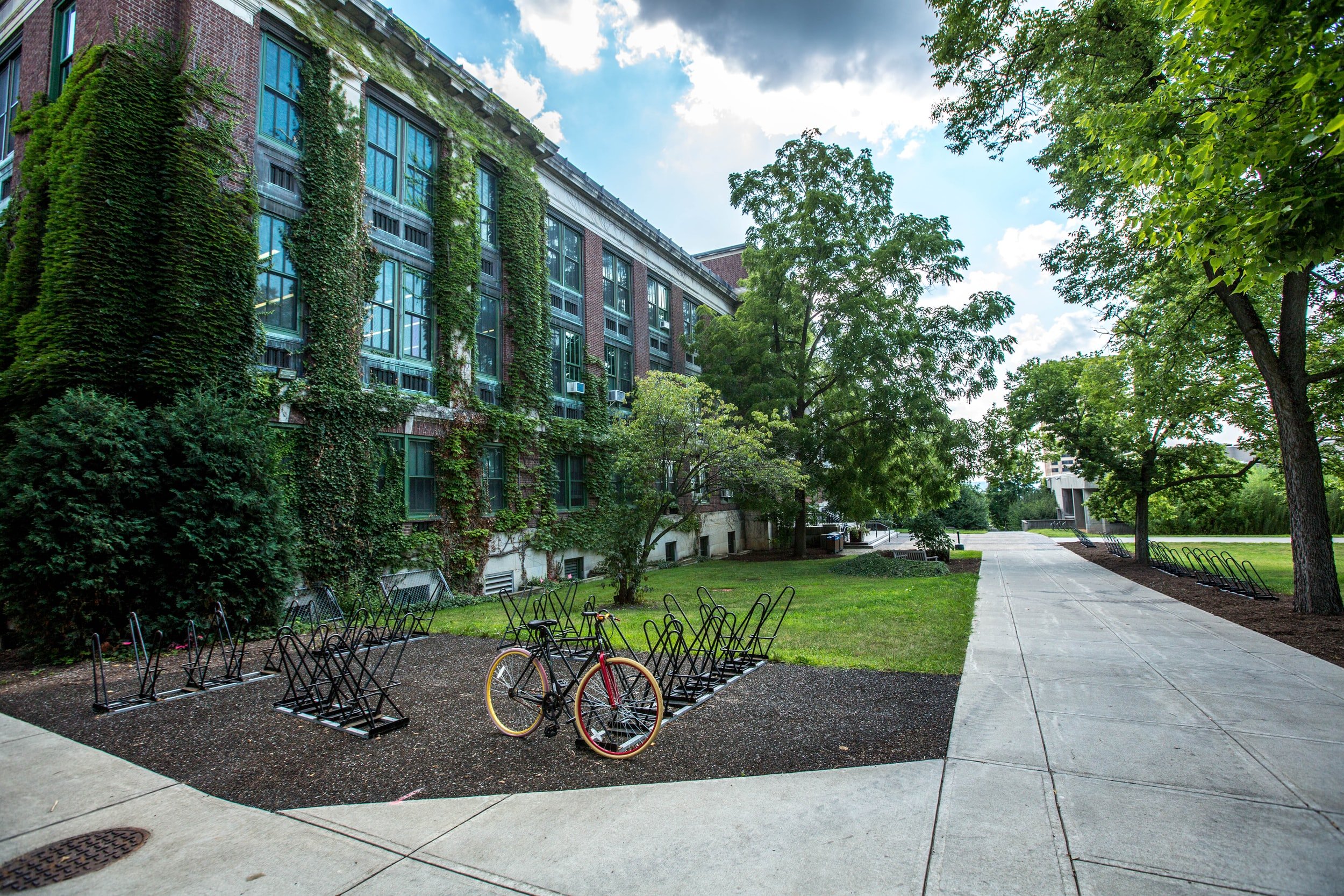
From energy consumption and waste to transportation construction -- all add up to a sizable environmental footprint. Empowering schools to green their built environment can create positive climate outcomes at scale, while modeling stewardship and solutions for their communities.

Metric #29: Chemical Management
This START metric is about following all city, state and federal regulations to properly dispose of hazardous, universal, and non-regulated chemical waste.
This START metric is about reusing or recycling electronics, following regulations for their disposal, and eventually using certified 3rd parties (e.g. eStewards or Responsible Recycling) to dispose of e-waste.
This START metric is about organizing annual clean-outs (including all students) aimed at reusing or recycling, and eventually employing source-reduction strategies, for any items usually discarded at the end of the school year.
This START metric is about diverting municipal solid waste (‘garbage’) from landfills or incinerators by recycling, composting, donating, exchanging or reselling.
Metric #33: Waste Minimization
This START metric is about reducing the amount of waste that your school generates in the first place (rather than diverting waste after it’s already been produced), e.g. through conscientious resource planning and procurement, investing in durable, quality items, adjusting consumption behaviors, improving work practices.
This START metric is about tracking and calculating the amount of GHGs your school emits (through electricity use, food waste, meat consumption, transport emissions etc.), offset against the amount of GHGs it proactively sequesters (e.g. through tree-planting, green building materials, biochar in soils, waste diversion)
This START metric is about decreasing the amount of greenhouse gases that your school is responsible for emitting. Reduction should start with energy efficiency, energy conservation, and renewable energy strategies.
Metric #36: Indoor Air Quality
This START metric is about improving indoor air quality through control of airborne pollutants (e.g. through ventilation-filtration systems), the introduction and distribution of adequate outdoor air, and the maintenance of acceptable indoor temperature and relative humidity.
Metric #37: Outdoor Air Quality
This START metric is about improving the quality of the air outside your school's buildings by addressing outdoor pollutants, e.g. through vehicle emissions, mobile sources (e.g. lawn care equipment, stationary sources (e.g. on-site generators) and pesticides.
Metric #38: Design & Construction
This START metric is about adopting Integrated Design - geared towards building greener and more energy-efficient facilities when undergoing remodeling or renovations.
This START metric is about adopting cleaning products and practices that preserve environmental and human health, using products that are Green Seal or Eco Logo certified.
Metric #40: Grounds Management
This START metric is about managing school grounds in ways that protect and promote environmental health and biodiversity, for example through Integrated Pest Management and sustainable land care.
Metric #41: Energy Consumption
This START metric is about reducing your school’s energy consumption.
This START metric is about transitioning to clean, renewable sources of energy to provide your school’s electricity and heating. Renewable energy can be procured from a renewable energy provider, or derive from on-campus sources (e.g. biomass technologies, or solar installations that are school-owned or school-hosted via third-party-owned purchase agreements).
This START metric is about implementing a school composting program, whether on-campus composting system or paying a service to collect and compost food scraps and bulkier materials such as cardboard.
This START metric is about sourcing food from local, ecologically-sound, fair and/or humane sources, for example, the green- and yellow- light categories of the Real Food Challenge ® standards.
This START metric is about offering vegetarian and/or vegan dining options for school meals, and later promoting the benefits of low-impact dining in the school community.
This START metric is about eliminating unnecessary waste generated by single-use tableware, by adopting reusable, recyclable or compostable tableware.
Metric #47: Employee Transportation
This START metric is about incentivizing sustainable commutes to work, for example through goal-setting, subsidizing public transit, installing bike share stations, or adopting flexible scheduling that allows for daily changes in plans.
This START metric is about using vehicles that run on alternative fuel and power technology, such as plug-in hybrids, fully electric vehicles, or vehicles fueled by hydrogen or compressed natural gas.
Metric #49: Student Transportation
This START metric is about working towards the goal of the majority, if not all, of your school’s student body using a form of sustainable transportation as the primary means of commuting, such as walking, biking, carpooling or vanpooling, public transportation, school shuttles, school buses, or hybrid/ electric vehicles.
Metric #50: Transportation Support
This START metric is about implementing structures and strategies to promote sustainable commuting to and from your school, for example carpool matching, providing preferential parking for carpool- and/ or alternative-fuel cars, providing bike racks and storage, shower facilities and lockers, providing free or reduced public transit options or campus shuttles, and providing electric vehicle recharging stations.
Metric #51: Drinking Water Access
This START metric is about providing access to safe, appealing drinking water on the school campus., ensuring water is safe (contaminant-free) and appealing (in terms of taste, odor, appearance, temperature and presentation).
Metric #52: Stormwater Management
This START metric is about using strategies and technologies to reduce runoff of rainwater or melted snow into streets, lawns and other sites, for example through prioritizing water-permeable surfaces on campus, and incorporating measures such as rain collection or harvesting, stormwater drains, retention ponds, bioswales or rain gardens into your school grounds.
This START metric is about reducing the total amount of water used at your school each year.

What is ‘Sustainability’?
“Meeting the needs of the present generations without compromising the ability of future generations
to meet their own needs.
Did you know that the mass of human-made things just exceeded the mass of all living things on earth?
Or that planet is now hotter than at any time in the past 125,000 years - and that there is near-universal consensus (97–99.9%) in the peer-reviewed scientific literature that the climate is changing as a result of human activity?
We need to learn, adapt and think creatively to solve these new challenges, and create a new future in which we work with our shared planet, instead of against it.

What is ‘Regeneration’?
Regeneration goes beyond sustainability by focusing not just on maintaining the status quo but on actively restoring, renewing, and enhancing natural systems, communities, and economies. While sustainability aims to "do no harm" by preserving resources for future generations, regeneration seeks to "do better" by improving the health and vitality of the systems we depend on.
Schools hold the key to a healthy, sustainable and regenerative future.
They are role-models and incubators that that nurture, educate and prepare each generation for adult life.
Schools have a unique opportunity and profound responsibility to become part the transition to a sustainable, regenerative future in which people and planet can thrive.
But how do we get there?
START: Sustainability Tracking, Analytics & Roadmap Tool was created by schools, for schools, to help them make step-by-step progress towards sustainability and regenerative practice.
START provides a Roadmap for School Sustainability:
It breaks down school sustainability into clear actions (‘metrics’), such as Minimizing Waste, Reducing Greenhouse Gas Emissions, and supporting Sustainable Transportation options.
However, research shows it’s not enough for a school to simply reduce its environmental impact.
Students and staff also need to learn about sustainability, and practice it in day-to-day activities, because this impacts their attitudes and behaviors when they leave school. That’s why START includes metrics like Sustainability Events for Students, Sustainability Course Content, and Sustainable Purchasing Practices.
How sustainable is our school now?
Schools use START to measure how sustainable they are now. A school’s START team investigates how their school currently operates to find their ‘sustainability baseline’ for each metric. For example, is our school a beginner, intermediate or advanced in sustainable water use?
START also enables schools to quantify and track their waste, water, energy and greenhouse gas emissions.
Where should we go next?
What do we need to do to ‘level up’ in each metric? Once schools have their baselines, START helps them to set goals and plan for progress.































